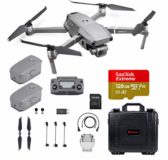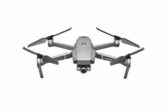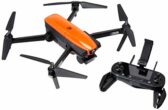The Best Professional Drones for Commercial Use in 2021
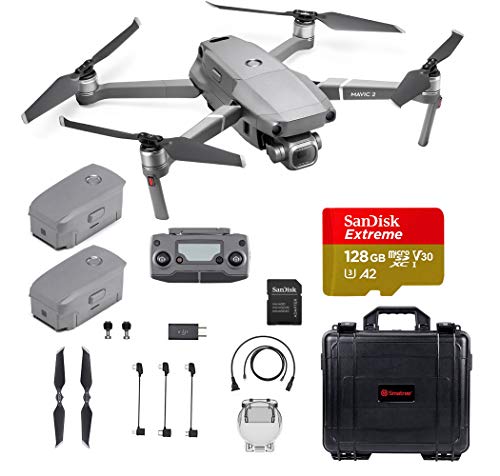
DJI Mavic 2 Pro
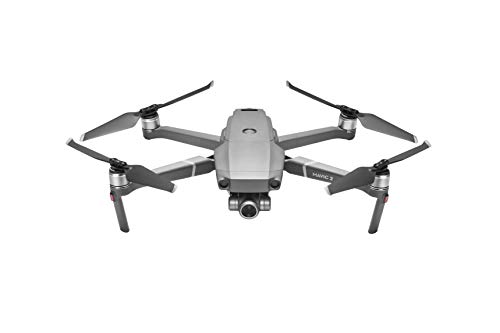
DJI Mavic 2 Zoom
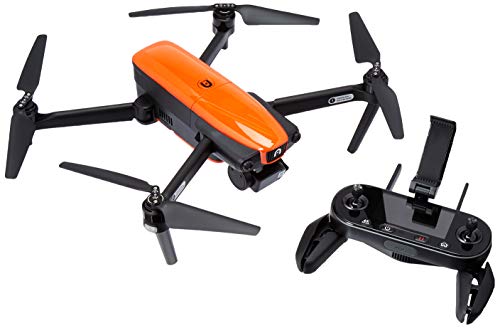
Autel Robotics EVO
Here we focus on the best commercial drones that are readily available to professionals and the general public. There are some extremely powerful ones out there, but we find that many are overkill for what most people are looking for.
The Best Commercial Drones
We may receive compensation on qualifying purchases via our links. This does not change how we review items. For more information, please read our affiliate disclosure.
Our favourite professional drone that can be used for a variety of commercial tasks is without a doubt the DJI Mavic 2 Pro.

- Flight Time: 30 minutes
- Range: 7 kilometers
- Camera: 4K resolution at 30 fps; 20 MP stills
- Weight: 1.64 pounds
- Gimbal: 3 Axis
When it comes to blurring the lines between consumer and commercial drones, nothing does it better than the DJI Mavic 2 series.
It’s jam-packed with specs and advanced features that make it the top choice among professionals and business owners everywhere.
Let’s start with the difference between the two before we delve into their commonalities. Both the Zoom and Pro versions have identical specs and features, save for one thing – the camera.
The Pro version has the better camera of the two by a long shot. It’s equipped with a Hasselblad L1D-20c 4K camera paired with a 20 megapixel 1″ CMOS sensor. This fantastic combination produces one of the best quality images and footage possible in a drone. For photographers and videographers, the Pro is the obvious choice.
When it comes to performance, the Mavic 2 Pro is unparalleled. This drone has one of the most extended flight times ever in a consumer drone, at 31 minutes. The transmission range is also one of the lengthiest at up to 8 km.
For commercial applications, this is a beast. It means you can fly the Mavic 2 for more extended and farther without interruptions. For surveying and construction, this is especially crucial.
The long-range also makes FPV transmission work smoothly, great for navigating the drone during roof inspections, for example.
The Mavic 2 is also chock-full of safety and auto features. It has staples like Return to Home, as well as a very robust Omnidirectional Obstacle Sensing. The forward, top, and side sensors can detect and avoid obstacles autonomously, while the bottom sensor can detect the ground for a safer landing.
The autonomous flight modes like Follow Me and Waypoints are also exceptional, using the DJI’s ActiveTrack visual recognition technology. This is an excellent feature for videographers to auto-tracking their subjects.
This just scratches the surface of what this drone is capable of. If you want the best all-around drone to tackle whatever commercial task you throw at it, the Mavic 2 shines bright.
+ Pros
The sister of the Mavic 2 Pro, the Zoom offers exceptionally flexible camera zooming.

- Flight Time: 31 minutes
- Range: 8 kilometers
- Camera: 4K resolution at 30 fps; 48-MP super resolution stills
- Take-off Weight: 905g
- Gimbal: 3-Axis
The Zoom version of the Mavic 2 uses a 24-88mm camera with 12-megapixel resolution and a 1/2.3″ CMOS sensor. It’s inferior photo quality-wise to the Mavic 2 Pro, but where it shines is in its flexibility. It can achieve up to 4x lossless zoom, giving you many more options in framing shots. With specific industries, this is the preferred way to go.
+ Pros
Knocking on DJI’s dominance of the consumer and commercial drone scene is the EVO from Autel Robotics.

- Flight Time: ~30 minutes
- Charge Time: ~210 minutes
- Range: 7050m / 4.4 miles
- Remote Controller: WiFi 2.4GHz (included in the set)
- Camera: 3-axis gimbal 4K 60fps camera with 12MP
- Live Video Transmission Range: 7000m / 4.3 miles
- Weight: 863g / 1.9lbs
- Carry Capacity: N/A
- Working Temperature: 0°C ~ 40°C
- Rated for outdoor use
The EVO drone is one of the few advanced drones that can compete with the Mavic 2 head-on. But where the EVO has a leg up on the DJI version is in its ruggedness.
This drone is a durable little flyer and can withstand crashes intact. It can also hold itself against strong winds while maintaining its altitude. Plus, the best thing is that it can survive a little drizzling of rain or snow. For commercial uses, this is a pretty big deal.
The battery life of the EVO is exceptional as well at 30 minutes, which is comparable to the best drones in the market. The range is an impressive 7 km, giving it excellent signal strength. FPV is, therefore, smooth and lag-free even at maximum distance.
The EVO’s camera is also a powerful number, capable of shooting at up to 4K HD resolution, with a 3-axis gimbal for stabilization.
It’s also one of the few drones that can shoot full 4K at a frame rate of 60 fps – giving it the ability to shoot great looking slow-motion footage. Not even the Mavic 2 can do that, which can only do up to 30 fps. This makes the EVO a good trick up a cinematographer’s sleeve.
Where this little flyer shines, however, is the advanced features in its compact frame. You can have access to its many autonomous flight features like Orbit and Follow Me, which is powered by Autel’s own visual recognition technology. These are really great for construction and surveying applications.
Overall, the Autel EVO is an advanced and powerful drone that ticks all the boxes. But what we love about this drone is its flexibility. It can certainly go where a lot of drones dare not. You can use it as a powerful photography drone one day, and an inspection drone for construction the next.
+ Pros
- Cons
We like to think of the Hubsan Zino Pro as a Mavic 2 or Autel EVO in a more affordable package.
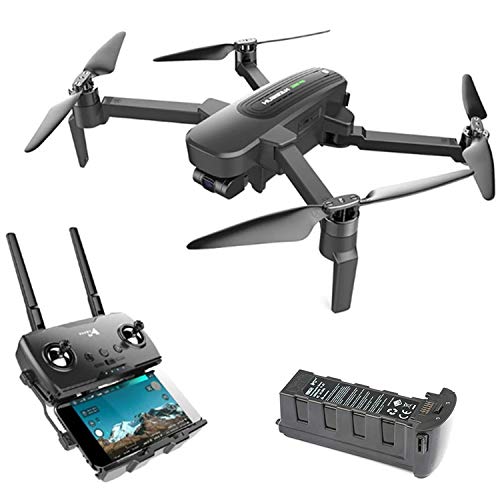
- Flight Time: 26 minutes
- Range: 4 km
- Camera: 4K UHD camera with 3-axis gimbal
- Weight: 710g
Granted that the specs have been pared down when compared to other professional drones in this post, but overall it’s still an impressive drone, especially at less than $500.
Let’s start with the performance. The Zino Pro has a flight time of up to 23 minutes, which is decent enough to be used in commercial applications. It can hover and maintain its position pretty well, plus has wind resistance up to Class 5. For outdoor applications, this drone definitely has the chops to deliver.
The Zino Pro’s range is also quite impressive at 4 km. This is the ideal range to have for most tasks that require standard distances. The transmission power also gives a smooth and fluid FPV experience, even when nearing the maximum range.
One of the selling points of the Zino Pro is its camera, making it great for photographers. It can shoot crisp and clear images and footage at 4K UHD resolution. It also has a 3-axis gimbal installed, so videos you shoot are buttery smooth without that annoying handheld amateur look.
The camera also features a removable lens, which can be swapped or equipped with filters. This gives you some creative freedom when taking photos. The lens is also adjustable, which can be rotated from 90 – 360 degrees, making framing easier.
Flight modes are limited, but what’s there is definitely useful. You can choose between Line Fly and Orbit modes for preset flight paths. If you want to set your own, you can use Waypoint Mode.
Safety-wise, the Zino Pro also got you covered. It has a smart failsafe installed, which directs the drone on what to do in case it reaches critical battery levels or loses signal strength. What sets it apart is that the Zino is smart enough to know if it can return to its origin point; if it can’t, then it will simply land in place.
All in all, we’re impressed with how the Zino Pro has all the essential features of a commercial drone in a relatively cheaper price tag. It’s a good drone for photographers, videographers, and real estate agents with smaller budgets.
+ Pros
- Cons
If your work requires the drone going anywhere near a body of water then you might want to consider the SwellPRO Splash Drone 3+.
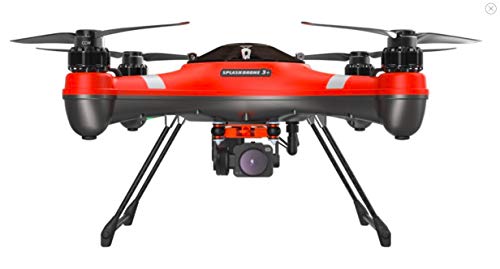
- Flight Time: ~22 minutes
- Charge Time: ~90 minutes
- Range: 1600m / 5250ft
- Remote Controller: WiFi 5.4GHz (included in the set)
- Camera: 90° adjustable 4K / 13MP camera
- Live Video Transmission Range: 1600m / 5250ft
- Weight: 1447 g / 51.04 oz
- Carry Capacity: 1000g / 35.27 oz
- Working Temperature: -10°C to 40°C
- Rated for outdoor use
The Splash Drone 3+ is a durable drone that’s completely waterproof, snowproof, and windproof. This makes it excellent for heavy-duty use.
The 3mm reinforced ABS body of this drone keeps everything sealed from the outside. This gives the Splash Drone 3+ the ability to float in water repeatedly. Heck, it can even take off from the water if it has to.
The applications of this drone are tremendous. You can use it to photograph subjects near bodies of water safely. You can deploy it to inspect structures or sites that are directly on the water. For surveying in harsh environments, few drones can do it other than the Splash Drone 3+.
The performance of the Splash Drone 3+, fortunately, matches up with its durability. It can achieve flight for up to 22 minutes and has a range of 1.6 km, which makes this drone usable for most applications.
Flight handling is agile and tight, and controls are pretty responsive. The powerful motors and S3 flight controller allow it to navigate rough waters and strong winds with ease.
The equipped camera of this drone shoots at a resolution of 4K UHD, which is enough to make this a decent photo drone. The wide-angle lens also accepts a more light, making it take great photos even in murky conditions. You can even shoot underwater since the camera is located in the drone’s underside.
One of its more unique features is the ability to carry a payload, which is done through its optional PL2 and PL3 add-on modules. Both allow you to take objects, such as bait or life vests, for search and rescue, up to 1 kg. They also have their own cameras built-in.
So if you ever need a heavy-duty drone, that would be the SwellPRO Splash Drone 3+. Being able to resist wind, rain, snow, and saltwater, it gives you the freedom to deploy it anywhere.
+ Pros
- Cons
A staggeringly powerful commercial drone that comes with a pricetag befitting of its capabalities.
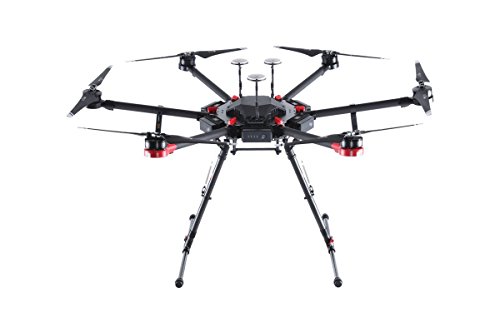
- Flight Time: ~25 to ~45 minutes (depending on the payload)
- Charge Time: ~6×180 minutes
- Range: 5000m / 3.1mi
- Remote Controller: WiFi 2.4GHz with 5.4Ghz video transmission (included in the set)
- Camera: FPV 2K Camera with 12MP
- Live Video Transmission Range: 5000m / 3.1mi
- Weight: 10Kg / 22lbs
- Working Temperature: Depending on the camera
- Rated for outdoor use
The DJI Matrice 600 Pro is undoubtedly the most powerful and capable commercial drone that we’ve included in this post.
For carrying top-of-the-range camera equipment and creating films, the Matrice 600 Pro is unrivaled.
In fact, the only reason we’ve not given this a perfect 5.0 rating as a professional drone is the fact that it probably includes too much for most people. For those looking for the best of the best and already have good camera equipment, this is arguably the best choice you could make.
+ Pros
- Cons
Our favorite compact drone, the Parrot Anafi is the perfect tool when you want to take quick photographs or inspections.
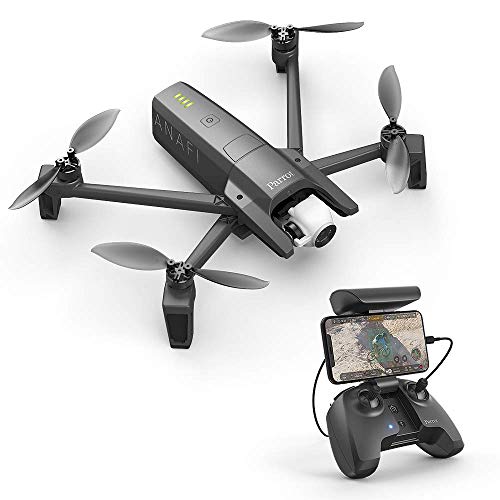
- Flight Time: ~25 minutes
- Charge Time: ~240 minutes
- Range: 4000m / 2.5mi
- Remote Controller: WiFi 5.4GHz & 2.4Ghz (included in the set)
- Camera: 180° adjustable f/2.4 ASPH lens 4K Camera with 21MP
- Live Video Transmission Range: 4000m / 2.5mi
- Weight: 320g / 11.28oz
- Working Temperature: -10°C to 40°C
- Rated for indoor and outdoor use
What we love about the Anafi is that it’s a nimble and agile drone. It’s especially remarkable for real estate or construction applications. It has a foldable and portable frame, which makes carrying it around and deploying it easy.
While the Anafi is a consumer travel drone, its performance more than qualifies it for commercial applications.
For one, the Anafi has an extended flight time of 25 minutes, which is more than enough for most applications. The flight time is pretty consistent, even with the camera turned on, thanks to this drone’s smart battery.
The Anafi also has an excellent range of 4 km, which gives it above average transmission power and distance. It can also zoom in at speeds of up to 55 km/h, which can be beneficial for things like inspections or surveying.
The surprising thing about the small Anafi is its relatively powerful camera. It has a 4K resolution camera equipped that can shoot stills at an impressive 21 megapixels. The 3-axis gimbal makes image stabilization a breeze and allows you to produce smooth cinematic shots.
For more hands-off flying, you can count on the Anafi’s autonomous flight modes. For roof inspections, you have the basics like Orbit Mode and Waypoints for smooth circling around the roof. For creative shots worthy of film, you have things like Parabola and Dolly Zoom.
When you want to take amazing overhead shots of your real estate property, we recommend Cameraman Mode. This makes the Anafi focus the camera on a specific subject, such as your house. You can then move the drone around freely, with the camera fixed at the subject. The result is a video showing the house or building at different angles.
Overall, the agile yet powerful Parrot Anafi is a flexible hobby drone that’s more than capable enough to do commercial tasks successfully. If you’re looking for a drone for both work and play, this is it.
+ Pros
- Cons
Not all commercial drones need to be premium, top-of-the-line machines, as shown with the HS720.
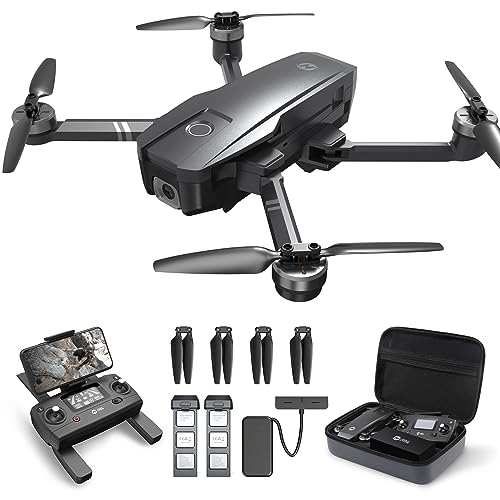
- Flight Time: ~26 minutes
- Charge Time: 5-7 hours
- Range: 800-1000m / 2624-3277ft
- Remote Controller: 2.4GHz transmitter included
- Camera: 2K HD (2048 x 1152) with shock absorption
- Weight: 459g / 1.01lbs
- Rated for outdoor use
Sometimes, you just need a dependable drone for light work, such as real estate photography or small scale inspections. For these situations, it makes much better sense to get a drone that’s inexpensive yet has all the essential features locked in.
Enter the Holy Stone HS720, an affordable drone that’s suitable for short-range work.
The HS720 has performance down pat. For starters, it has longevity for most commercial requirements. Its brushless motors are energy-efficient enough to make it fly for up to 26 minutes, not to mention giving excellent lifting power.
The range of the HS720 is a bit shorter for a commercial drone, at a little less than 1 km. This makes the drone ideal for applications that don’t require vast distances.
The camera equipped in the HS720 is at a decent 2K HD resolution, which is crisp enough but nothing to write home about. But the great thing about it is the shock absorption feature, which does a pretty decent job at stabilizing your image.
This makes the HS720 is a decent drone to do real estate tours with. It’s nimble and stable enough to fly around the property and record some really nice footage. The intuitive and responsive controls make navigating through tight corridors in the house especially easy.
GPS-powered safety features like Return to Home (RTH) are fortunately present in the HS720. It’s also the main driving force behind its smart flight modes like Custom Path and Orbit Mode, which are both useful for taking aerial shots of your property.
In the end, the Holy Stone HS720 is a cost-effective, light commercial drone. It’s actually a personal favorite for real estate projects, which you might like as well.
+ Pros
- Cons
What Are The Different Types of Commercial Drones?
Drones are so flexible that they have changed the landscape of a lot of industries. Here are some ways commercial drones are used:
Wedding Photography and Videography
One of the first industries to be changed by drones was photography, specifically wedding photography. This allows for more unique and breathtaking ways to capture a couple’s special day that was previously impossible.
Now you can have awesome shots like a bird’s eye view of the ceremony and reception, 360-degree orbit shot of the couple, or a classic panning + zooming out shot.
A lot of couples nowadays also opt for a pre-nuptial photoshoot days before the wedding. This is usually done in some exotic locale or a place that has significance to the couple, such as where they first met. Drones add a special cinematic magic touch to these photos and videos.
Outdoor Photography
Outdoor enthusiasts have been using drones to take selfies and photos of their hiking trips, and professional photographers are quick to take notice. Now, drones are starting to have a place in the bag of tricks of landscape and wildlife photographers.
Drones allow outdoor photographers a new vantage point from which to take photos. Higher angles can make for much more unique and breathtaking shots. Plus, the photographer doesn’t even need to risk himself by climbing trees or cliffs just to get a good shot.
Wildlife photographers can also better capture animals from a distance using drones. Not only will this not disturb the wildlife, but it’s also safer for the photographer. There are lots of silent drones out there that can get the job done.
Filmmaking
For the most demanding video shoots, look no further than Hollywood. Movie magic often requires impossible looking shots like filming from high above a cliff, under a bridge, or following a fast-moving vehicle around.
Fortunately, drones are more than happy to oblige, and filmmakers are embracing UAVs as a filmmaking tool. Aerial shots used to involve hiring a costly helicopter or deploying complicated equipment. Drones simplify the process and lower the overall cost.
Drones also allow filmmakers to shoot difficult shots in challenging locations where setting up equipment is impossible, such as forests or mountains. Advanced drones also have autonomous flight features, which is useful for accurately flying the same path for multiple takes.
Live Coverage
Drones also make it easier to do TV coverage of live events, such as concerts or rallies. Reporters used to require a full crew and lots of equipment to capture these events. The large crowds that are often present can make things much more difficult to setup.
It’s much easier to deploy a drone and fly over the crowd to get fantastic angles of the event. You can even use multiple drones to cover different perspectives of the event.
Aerial coverage is also much more accessible. This used to be done with helicopters, which are more expensive to hire. Plus, helicopters can’t descend down to specific areas the way a drone can.
Drones can also help reporters do TV coverage of dangerous locations, such as war-torn areas or fires. With it, the crew can operate from a safe distance while still getting to capture the events close-up.
Real Estate
When it comes to real estate, first impressions are essential. With the majority of house hunters now browsing properties online, this is often done with photos or video tours.
Drones can give your real estate an edge by providing impressive-looking shots. You can do an aerial photo to provide prospects an overview of the property, and then even use the drone to shoot a video tour of your home. This gives your prospects a sense of the property and entices them enough to schedule an actual viewing with you.
And thanks to a drone’s stability, your real estate videos will look smooth and professional, and not jittery and amateurish.
Roofing and Construction
Drones are a welcome tool for architects and construction firms and are used in every stage of the process.
During construction, drones help inspect roofing much more accurately. This used to be done via manually laying measuring instruments on the property, which can introduce some error. Drones simply take an aerial photo and, through software, precisely measure a building or plot’s dimensions.
Drones are also great as an inspection tool. Contractors can verify if every inch of the building is built well and according to standards. Roofing contractors can utilize drones to inspect roofing, saving them the trouble and danger of climbing it themselves.
Surveying
Surveying is a complicated task that accurately measures a specific plot of land. As you can imagine, this involves a lot of computations and data. Usually, this requires you to go out in the field to get the data yourself, often for multiple times
A drone for surveying can become a game changer. First, they can take photos and videos from a higher vantage point, which makes measuring easier. The drone will then capture a photo or video of the area, which can be used by software to do the measurements for you.
Agriculture
One of the industries where drones can have a significant impact is in agriculture. The simple reason is that farmlands usually have vast stretches of land, which is difficult to tend to or gather data from. UAVs help by giving farmers an eye in the sky.
Drones can gather useful data, like check on the health of their crops or their livestock population, much more quickly than doing it on foot. They can also use it to get a picture of a farm’s irrigation system, to improve it further.
But drones are used far more than just an observation tool. Some drones can actually carry water and pesticides, and deploy it on the crops. It’s much more efficient and cheaper than using traditional crop-duster.
Performance Art
Drones are increasingly being used in shows and performances worldwide. Multiple drones can be made to move in a coordinated way, much like how individual swimmers are in synchronized swimming.
Individual drones can also light up in different colors, which can form a picture when viewed from afar, much like how a mosaic is made. Performance drones are still in its infant stages, but the future for it looks promising.
Do You Need A License For Commercial Drones?
In most countries, if you are to operate a commercial drone, you need a license or permit to do so. The specific rules and regulations differ from country to country and even city to city.
Drone use is usually in the jurisdiction of a government’s aviation agency. In the US, for example, this is the Federal Aviation Administration (FAA). This is because drones are considered a type of aircraft.
To get a license, you first need to pass a certification course. This always involves a knowledge test and a practical exam to test actual flying skills. There is usually a minimum age requirement to qualify, which is around 16 years old on average.
Even with a license, there are always restrictions you need to adhere to when flying your commercial drone. These involve avoiding flying in prohibited airspace (airports, military bases) and only at certain speeds. The drone itself would also need to be registered.
For more information on getting a drone license, check out these resources:
- For US residents: FAA Remote Pilot Certificate page.
- For Canada residents: Drone Pilot Certificate
- For UK residents: Commercial drone pilot permission information
- For Australia residents: CASA Remote Pilot License
- For all other countries, check with your country’s aviation agency for more details
Buyer’s Guide: Commercial Drones
Compared to hobby drones, a lot more is expected out of a commercial drone. Every minute they can’t operate out in the field is going to cost money. Hence, these drones need to be robust and reliable, with the best specs available.
Regardless of the industry, here are some of the common factors of good commercial drones:
Flight Time
Flight time is one of the most critical elements of any commercial drone, as they need to spend as much time as they need to in the air.
A lot of applications, like wedding photography and roof inspections, can take more extended periods to achieve great results. Slowing down to charge or swap batteries merely is unacceptable and may cost you money.
Commercial drones need the most extended flight times they can get. Anything above 20 minutes is the absolute minimum, with 30 minutes being the gold standard. It’s also vital that you invest in a few extra batteries on hand, and an external charger to top up any used up spares. For day-long engagements such as for photoshoots, it’s the only way to keep up.
Range
Range defines how far out your drone can fly before you lose control of it. It’s an often overlooked spec in hobby drones, but one that you should absolutely consider for a commercial drone.
For some industries that deal with larger areas, like agriculture and construction, long-ranged drones are a must. Outdoor and wildlife photographers also need this to be able to extend the area which they can capture. And even if you’re just doing wedding photography, you never know when that range can come in handy.
A good range to shoot for is around 4 km, as it gives a good balance of distance vs. cost. If you know you’ll be deploying your drone in extreme distances, go for 8 km.
FPV
For most applications, drones are primarily used as an eye in the sky. This means it should give you a real-time view of what the drones “sees” via its camera. This is achieved through First Person View or FPV.
The number one thing you need when it comes to FPV is transmission strength. This will make the live video feed stream to your smartphone or controller as real-time as possible, without any lags. This is vital when you’re using FPV to navigate your drone (i.e., during inspections), as any FPV lag can delay your reaction time, which can lead to crashes.
The video quality of the FPV is a secondary concern, although still relevant. Aim for 1080p HD quality, although 720p HD is good enough for drone navigation purposes.
GPS
One of the chief reasons for getting a GPS onboard your drone is that you’ll know its exact location at any given time. For industries where you don’t have a line of sight with your drone, this is essential in case the drone gets lost.
But more than that, GPS opens up a slew of new abilities for your drone. For one, it allows your drone to accurately maintains its position even if it gets knocked out. It’s also necessary for a lot of a drone’s advanced flight and safety features, which we cover on next:
Safety Features
Drone crashes are catastrophic. Not only does the drone itself cost money to repair, but it can also disrupt your operations, which arguably costs a lot more. That’s why drones need to have safety features installed.
The minimum you should go for is Return to Home (RTH). This GPS-powered feature makes the drone automatically return to its takeoff point whenever its battery gets too low, or when it loses its signal. This prevents the drone from shutting down mid-air and crashing.
Getting drones with Obstacle Avoidance is also prudent. These would have sensors around the drone’s body, which can detect whenever it’s about to crash with an obstacle. Some drones will then automatically avoid the obstruction or hover safely in place.
Also, never underestimate the importance of indicators! Your remote controller or smartphone app should alert you during key triggers like low battery, weak signal, or if the drone is flying at an unsafe altitude.
And remember, safety features should never replace a pilot’s skill. Always fly any drone safely.
Autonomous Flight Modes
Drones have different autonomous flight modes that are useful with specific applications.
Roof inspections, for example, benefit from Orbit Mode, which makes the drone autonomously circle a house around. It allows you to focus on inspecting the roof rather than flying the drone.
Another example is Waypoint Mode, which a filmmaker can use to execute complicate shots easily by drawing a flight path for the drone to follow. The added bonus is that these paths are repeatable, making it easy as well to do multiple takes.
We recommend taking into consideration how you would use your drone, explore the different auto flight modes of a drone, and choose accordingly.
Camera Quality
For photography and videography applications, this is the #1 concern. Fortunately, the specs of a drone’s camera can pretty much compete with the best pro SLR cameras and film cameras out there.
Specs-wise, it’s pretty easy – 4K UHD video resolution is a non-negotiable, as well as anything above 15 megapixels for photos. The CMOS sensor is as much an essential concern as the resolution, and you should go for sizes of 1″ and above.
If you’re doing video, image stabilization is a must-have. This is done with a gimbal. This is a mechanical device that can rotate the camera independent of the drone. By canceling out the drone’s movement, it keeps the camera as stable as possible.
Gimbals also allow you to tilt the camera in angles ranging from 0 – 180 degrees. Together with zooming (make sure it’s lossless), it can help you frame shots better at a distance, a requirement for some applications.
Weatherproof
Because they perform a crucial role, commercial drones need to be as durable and rugged in the field as possible. At the minimum, they should be able to withstand moderate to strong winds without losing their altitude or position.
If possible, also get a water-resistant drone. You never know what will happen outdoors, and it’s unfortunate if a light drizzle will delay your drone’s tasks. With an utterly weatherproof drone, you can still carry on and finish your operations on time regardless of the weather conditions.
Carrying Capacity
Depending on the activity you’re carrying out, some commercial drones need to be able to bring different instruments, such as LIDAR or thermal cameras. Others, like in agriculture, are used to carry and drop a payload in the field.
If your industry requires these kinds of devices, then your drone should be able to accommodate them.
An important consideration here is the maximum carrying capacity that your drone can handle. Most professional drones should have a capacity in the range of 18kg on average.

